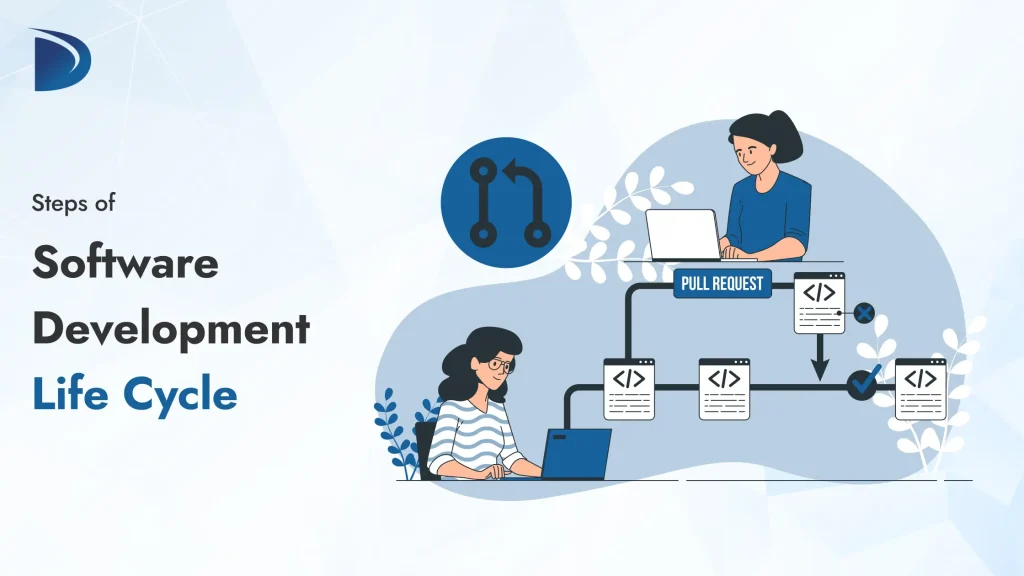Table of Contents
The Software Development Life Cycle (SDLC) is a structured process that guides teams in creating high-quality software. It breaks down the development process into clear steps, ensuring the software is planned, built, tested, and maintained effectively. This guide explains the steps of the SDLC in easy English, with a logical flow to help beginners and developers understand the process.
What is the Software Development Life Cycle (SDLC)?
The SDLC is a step-by-step framework used to develop software in an organized way. It helps teams plan, design, build, test, and maintain software while meeting user needs and staying on time and budget. Each step has a specific purpose, and following the SDLC reduces errors, improves teamwork, and ensures the final product works well.
- Purpose: To create reliable software efficiently and meet user expectations.
- Example: Building a mobile app for online shopping follows the SDLC to ensure it’s user-friendly and bug-free.
Why is the SDLC Important?
The SDLC provides a clear roadmap for software projects.
Here’s why it matters:
- Organized Process: Keeps tasks in order, so nothing is missed.
- Better Quality: Includes steps to catch and fix issues early.
- Saves Time and Money: Planning and testing prevent costly mistakes later.
- Team Collaboration: Helps everyone understand their roles and work together.
- User Satisfaction: Ensures the software meets what users want.
Steps of the Software Development Life Cycle
The SDLC typically includes six to seven main steps, depending on the project. Below is a clear explanation of each step, with examples and goals.
1. Requirement Gathering and Analysis
This first step involves understanding what the software needs to do. The team talks to clients, users, or stakeholders to collect their needs, which are written down as “requirements.”
- Tasks: Hold meetings, create surveys, or write user stories to define what the software should do.
- Example: For a shopping app, requirements might include, “Users should browse products, add items to a cart, and pay online.”
- Goal: Clearly understand the project’s purpose and user needs.
- Output: A requirements document that guides the project.
- Tools: Google Docs, Jira, or Confluence for documenting requirements.
2. Planning and Feasibility Study
In this step, the team creates a plan to build the software and checks if the project is possible. They look at the budget, timeline, technology, and risks to ensure the project can succeed.
- Tasks: Define the project scope, set deadlines, assign team roles, and choose tools or programming languages.
- Example: Plan to build the shopping app in 6 months using Python and a cloud database, with a team of 5 developers.
- Goal: Create a roadmap and confirm the project is doable.
- Output: A project plan or feasibility report.
- Tools: Trello, Microsoft Project, or Asana for planning.
3. System Design
The team designs how the software will look and work. This includes planning the user interface (UI), user experience (UX), and technical structure (like databases or servers).
- Tasks: Create wireframes (basic layouts), design system architecture, and choose technologies.
- Example: Design a shopping app with a homepage, product page, and checkout page, plus a database to store user data.
- Goal: Build a clear blueprint for the software’s appearance and functionality.
- Output: Wireframes, mockups, or technical diagrams.
- Tools: Figma, Sketch, or Visio for design.
4. Development (Coding)
This is where developers write the code to build the software based on the requirements and design. They work in small parts, often using methods like Agile to break the work into “sprints.”
- Tasks: Write code, integrate components, and follow coding standards.
- Example: Code the shopping app’s product page to display items and an”Add to Cart” button.
- Goal: Create a working version of the software.
- Programming Languages: Python, JavaScript, Java, C#, or others.
- Tools: Visual Studio Code, GitHub, or IntelliJ for coding.
5. Testing
Before releasing the software, the team tests it to find and fix bugs. Testing ensures the software works as expected and meets the requirements.
- Tasks: Run tests to check functionality, performance, security, and usability.
- Example: Test the shopping app to ensure users can add items to the cart without errors.
- Types of Testing:
- Functional Testing: Checks if features work (e.g., “Does the payment button work?”).
- Performance Testing: Ensures the software runs smoothly under heavy use.
- Security Testing: Protects against hacks or data leaks.
- Goal: Deliver a reliable, high-quality product.
- Tools: Selenium, Postman, or JUnit for testing.
6. Deployment
Once tested, the software is released to users. It’s uploaded to a website, app store, or server where users can access it. Deployment may happen in stages, like a beta release to a small group first.
- Tasks: Set up servers, upload the software, and monitor the launch.
- Example: Publish the shopping app to the Google Play Store and Apple App Store.
- Goal: Make the software available for users to use.
- Tools: AWS, Heroku, or Firebase for hosting and deployment.
7. Maintenance and Updates
After launch, the team supports the software by fixing bugs, adding new features, and improving performance based on user feedback. This step continues for as long as the software is in use. User feedback is crucial in this step as it helps the team understand how the software is being used in the real world and what improvements can be made to enhance the user experience.
- Tasks: Monitor performance, respond to user issues, and release updates.
- Example: Fix a bug in the shopping app that causes slow loading, or add a feature for user reviews.
- Goal: Keep the software running smoothly and up to date.
- Tools: Bug tracking tools like Jira or analytics tools like Google Analytics.
Common SDLC Models
The SDLC can be applied using different approaches, depending on the project. Here are some popular models:
- Waterfall: Follows the steps in a strict order, completing one before starting the next. Best for projects with clear requirements.
- Agile: This model breaks the project into small cycles (sprints) for flexibility and frequent updates. It’s a great choice for projects that may change, providing a sense of reassurance that the process can adapt to evolving requirements.
- Spiral: Combines planning and testing in loops, focusing on risk management. Used for large, complex projects.
- DevOps: Focuses on continuous development, testing, and deployment for fast releases.
Each model uses the same SDLC steps but organizes them differently based on the project’s needs.
Common Tools Used in the SDLC
Teams use various tools to manage the SDLC process:
- Requirement Gathering: Jira, Confluence, or Google Docs for documenting needs.
- Planning: Trello, Asana, or Microsoft Project for task management.
- Design: Figma, Adobe XD, or Sketch for wireframes and mockups.
- Development: GitHub, Visual Studio Code, or PyCharm for coding.
- Testing: Selenium, Postman, or TestRail for quality checks.
- Deployment: AWS, Docker, or Jenkins are used to launch the software.
- Maintenance: Zendesk, Jira, or Mixpanel for tracking issues and feedback.
Best Practices for a Successful SDLC
To make the SDLC work well, follow these tips:
- Communicate Clearly: Keep the team, clients, and users informed at every step.
- Document Everything: Write down requirements, plans, and changes to avoid confusion.
- Test Early and Often: Catch issues during development, not just at the testing stage.
- Involve Users: Get feedback from users during design and testing to meet their needs.
- Use the Right Tools: Choose tools that fit your team and project size.
- Follow a Model: Pick an SDLC model (like Agile or Waterfall) that suits your project.
- Plan for Maintenance: Build software that’s easy to update and support.
Challenges of the SDLC
While the SDLC is helpful, it can have challenges:
- Changing Requirements: Users may want new features mid-project, causing delays.
- Time Constraints: Tight deadlines can lead to rushed steps, like skipping tests.
- Miscommunication: Teams may misunderstand requirements or goals.
- High Costs: Large projects may go over budget if not planned well.
To overcome these, plan carefully, communicate often, and use flexible models like Agile when requirements might change.
Conclusion
The Software Development Life Cycle (SDLC) is a proven process for building great software. By following its steps, requirement gathering, planning, design, development, testing, deployment, and maintenance teams can stay organized, reduce errors, and deliver products that users love. Each step has a clear purpose, and using the right tools and practices makes the process smoother.
Whether you’re new to software development or an experienced professional, understanding the SDLC helps you create reliable, high-quality software. Stick to the steps, involve your team and users, and keep improving to achieve success in your projects.

